
Introduction
Regular visitors to Sensors Expo know the many benefits of attending such sector gatherings. You may get wind of a number of innovative products, identify new market entrants, and spot both emerging and fading market trends, etc. This article highlights how instrumental patent information can be in doing all of the above.
After discussing the many upsides of monitoring patent information, a hands-on guide to searching patent information online based on the international classification scheme is provided. Focus is laid on temperature measurement sensors, the area of expertise of the author of this article at the European Patent Office (EPO), as well as on the functionalities of the EPO's patent information search portal Espacenet.
Furthermore, an analysis of the patent filing figures in the field of temperature measurement is presented, including a study of their evolution in the last 10 years together with an analysis of the countries and companies that are most active in the field.
Benefits of Monitoring Patent Information
Patent information is vital to a broad range of professions from technical developers and researchers to legal advisers and business strategy managers. There are many good reasons for using patent information. More than anything else, it can help you make informed decisions when choosing strategies for researching or developing new products. You can use patent information to find out what already exists and build on it. Also, should you be faced with a technical problem, there is no better way of finding out what solutions already exist than by looking at patents
Keep Track of Who Is Doing What
The technical details of research being carried out by your competitors may well appear first in a patent document, long before the product reaches the marketplace. By monitoring patent documents you can keep an eye on your business competitors, or even locate potential partners.
You can also use patent information to identify patents that are no longer in force and can be freely used. Finally, by watching patent publications, you can spot trends in technology or the market at an early stage.
Additionally, you must avoid infringing other people's patent rights. Before you put a new product on the market or offer a new service, you need to make sure that you will not be infringing someone else's patent. Patent information will help you there as well.
Searching In Temperature Measurement Patents
To make searching easier, every patent is classified. A classification scheme is a system of codes that groups published patents and patent applications according to technical areas. Patent offices worldwide use the International Patent Classification (IPC) scheme, a very detailed scheme enabling the accurate classification of the invention of each published document.
There are approximately 70,000 different IPC codes for different technical areas. Although this may already seem a very large number, the European Patent Office (EPO) and the US Patent and Trademark Office (USPTO) created the Cooperative Patent Classification (CPC) which is based on the IPC. It contains more than 250,000 codes. Temperature sensors are classified in IPC groups G01K1 to G01K19. It is a hierarchical scheme which is useful for focussing on the subject of search.
IPC classification main scheme for temperature sensors
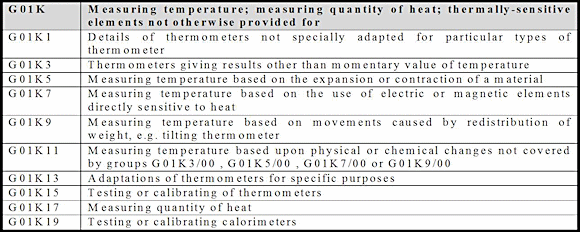
Fig. 1
The head groups in fig. 1 above constitute the backbone of the G01K IPC classification scheme which is completed by 124 subgroups. The CPC scheme, which is more refined than the IPC scheme, has about 200 G01K subgroups. These specific codes form a multi-dimensional matrix which allows for easy retrieval of prior art according to various criteria. With the CPC scheme, it is for instance possible to search for temperature sensors depending on the physical principle used for sensing, on the specific application of the sensor, or on further constructional details, as listed below.
Search by physical principle used for temperature sensing:

Fig. 2
In fig. 2 above, the US patent application US2013121373 A1 relating to an ultrasonic temperature measurement device is, e.g., classified in G01K11/24, a subclass of G01K11/22.
Search by kind of application:

Fig. 3
As per fig. 3, the EP patent application EP2700924 A2 relating to a high temperature resistive temperature detector for exhaust gas temperature measurement is, e.g., classified in G01K13/02.
Search for constructional details:

Fig. 4
Fig. 4 shows the international patent application WO2010116517 A1 relating to a protective tube of thermometer is, e.g., classified in G01K1/08.
Espacenet
An easy way to retrieve patent information is to use the Espacenet portal provided by the EPO. Espacenet offers free access to about 85 million patent documents from more than 90 patent authorities worldwide, containing information about inventions and technical developments from 1836 to today. Three search options are available: smart search, advanced search and classification search.
Smart Search
The smart search option is a single line patent search tool convenient for both beginners and experts. It allows for simple entry of search terms of different categories (names, dates, numbers, etc.) as well as command lines with operators and field identifiers. For instance, in fig.5, the straightforward command "Tokyo Electron G01K 2013" outputs 10 patent applications of Tokyo Electron classified in G01K and published in 2013.

Fig. 5
The equivalent command line search would be: "((ia = Tokyo and ia = Electron) and cl = G01K) and pd = 2013". With knowledge of the field identifiers, operators and syntax, quite complicated search statements can be constructed. Advanced Search In the advanced search mode (see fig. 6), one can look up patents by one or several of 10 different bibliographic criteria (title, inventor name, publication date, CPC class, etc.) in a worldwide collection of published applications from more than 90 countries. If you limit the scope of search to EP or PCT published patent applications, a keyword search in the full text of the respective published patent specifications is also possible. For example, a keyword search in the EPO database in the IPC group G01K will output only 28 documents containing the word string "skin temperature".
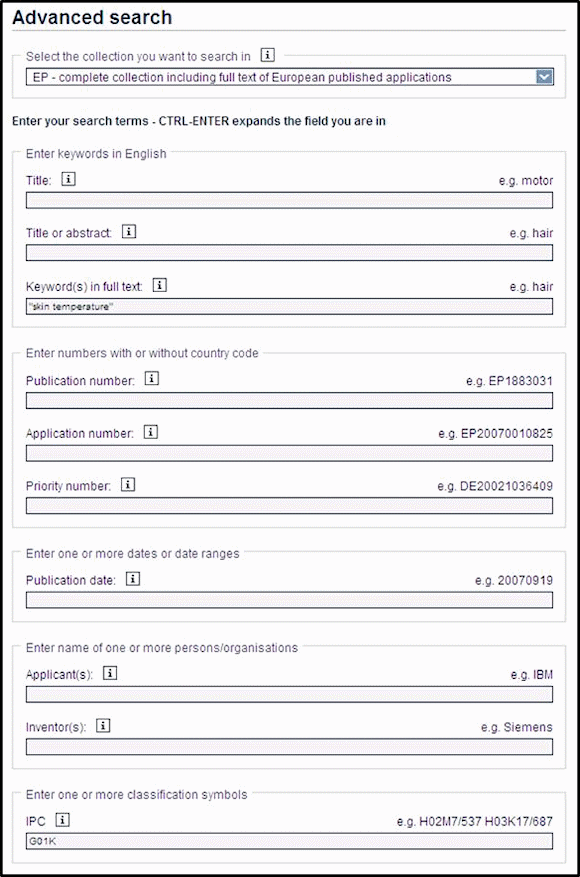
Fig. 6
If you are looking for the appropriate class to search for prior art, the classification search mode is rather handy. It allows you to quickly navigate from the most general sections A (human necessities) to H (electricity) to the most refined subgroups. In fig. 7, for instance, the subgroup code corresponding to the calibration of temperature sensors can be found after a couple of clicks, it is G01K15/005.
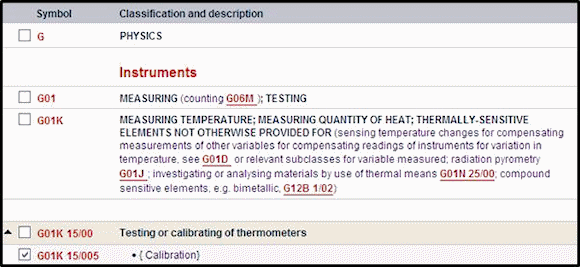
Fig. 7
Alternatively, subgroup codes can be found by typing keywords in the keyword search field of the classification search mode. The first hit obtained by typing the keywords "calibration temperature sensors" is for instance G01K15/00 (see fig. 8). One may want to click on the main group code to further expand it and find the subgroup code corresponding to calibration of temperature sensors, i.e. G01K15/005.

Fig. 8
Statistical Analysis Of Documentation In The IPC Field G01K
About 120,000 patent families are classified in the IPC group G01K. Since all patent offices worldwide use the IPC scheme, it is a convenient tool to analyse global trends in the field of temperature measurement.
Geographical Distribution Of G01K Patent Applications:
The following graph in fig. 9 gives a yearly breakdown of the geographical origin of the patent applications classified in G01K in the last decade.
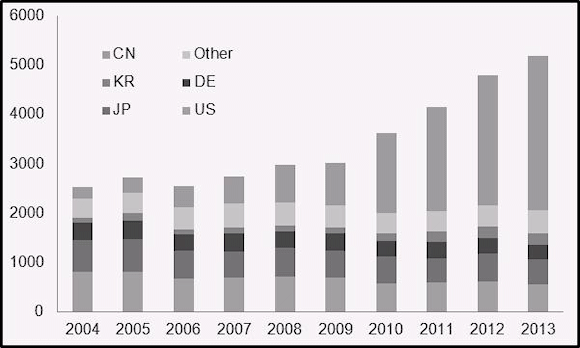
Fig. 9
In the last 10 years the total number of filings in the technical field of temperature measurement has more than doubled. While US, Japanese and German applicants were largely dominating the G01K landscape a decade ago with respectively 30%, 24% and 13% of the patent applications filed in 2004 originating from these 3 countries, the last few years have witnessed the emergence of new players in the temperature sensor market, especially from China. Accounting for less than 10% of the total number of applications back in 2004, Chinese applications indeed amounted to almost 60% of the volume in 2013.
G01K Top Five Applicants Worldwide In 2013

Fig. 10
Not surprisingly, as seen in fig. 10, the first-ranked applicant in 2013 was from China, the filings of the Chinese state-owned State Grid Corporation of China adding up to 187, about 3% of the total volume. Well-established applicants Bosch, Siemens, Toyota and Terumo complete the top five.
Evolution Of The Number Of Published Patents From G01K Top Five Applicants
While Bosch, Siemens and Toyota have a rather constant baseline of 20-50 filings per year over the last decade (see fig. 11), the number of filings from new entrant State Grid Corporation of China has grown exponentially within only a couple of years. The 2002-founded Chinese power grid operator indeed filed its first-ever G01K application in 2010 to reach almost 200 filings 3 years later.
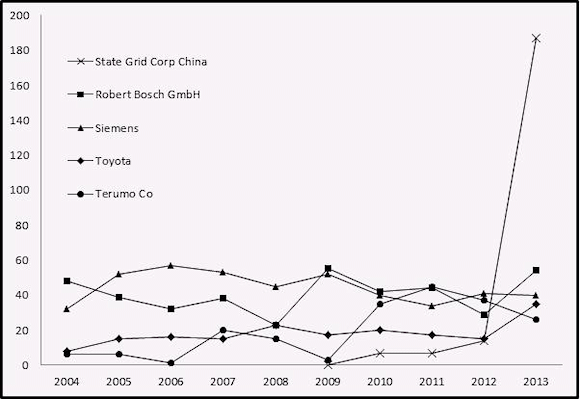
Fig. 11
Conclusions
As highlighted in this article, monitoring patent information is a powerful tool for helping a range of professionals making educated decisions in their daily work. Searching for patent information efficiently requires however a deal of specialist knowledge, in particular about the International Patent Classification (IPC) scheme and the further refined Cooperative Patent Classification (CPC) scheme. The above introduction to the hierarchical structure of these schemes, with the example of the temperature measurement group (G01K), and to the EPO's patent search portal Espacenet may help interested professionals finding their way through the patent information maze. The last section of this article gives an overview of the patent landscape in the specific subgroup of temperature measurement sensors as a way of highlighting recent trends through the lens of patent information.
The author of this article, as well as his EPO colleagues Michiel de Bakker, Marcel Daman and Carlo Bagnera, will attend the Sensors Expo 2014 on June 24-26 in Rosemont, IL. Please feel free to contact him ahead of time if you wish to meet and have a chat at Sensors Expo and learn more about the European patent system.
About the Author
Matthieu Rosello-Garcia works as a patent examiner in the field of temperature sensors at the European Patent Office (EPO) in The Netherlands. Before joining the EPO, he worked as a science analyst at the French Embassy in Japan and spent a few years in the semiconductor industry working for Infineon Technologies and Qimonda in Germany. Mr. Rosello-Garcia holds a MS degree in Industrial Engineering from Ecole Centrale de Lille (France), a MA degree German Studies from Strasbourg University (France), and recently graduated from the Executive Training Program from Yonsei University (Korea).